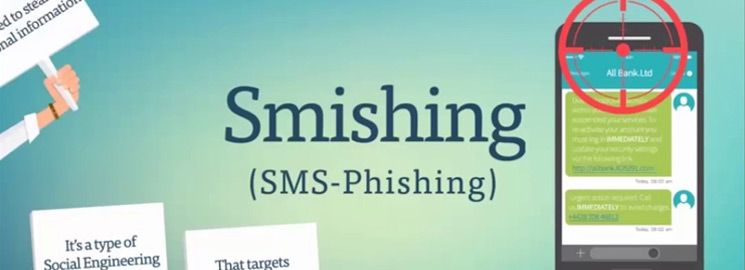Internet scam artists are moving beyond your email inbox and are now targeting your text messages instead. With this new scam, called “smishing,” scammers are trying to get you to send them your personal information that could help them access your bank account or other online profiles.
So, what exactly is smishing?
Smishing scams are so named because they’re like a phishing email scam, except sent via SMS, the technology behind a typical text message.
In these types of frauds, scammers often prey on people’s panic or sense of urgency, whereby you get a text message from a number you may or may not recognize looking for some type of personal information.
For instance a warning from your bank about an unauthorized charge that needs your attention right away. For people who get tricked by smishers, you quickly tap on a link in the text or reply to the text with revealing personal information and from there the scammer can make you think they are legit, just looking for some personal information.
Is smishing a new type of scam?
It’s been around since 2008, but experts say they are becoming more prevalent now since texting is so common. Not just found in your list of text messages, smishing messages are also pop up on all sorts of other messaging apps like WhatsApp, Facebook Messenger, Snapchat and WeChat.
Why are scammers using this type of scam?
Scammers could have one of several motives. They could be trying to steal someone’s identity, to access their bank account, or to blackmail someone into giving out personal or company secrets. That’s seems to be where they are making the most money.
Because people are getting more suspicious of emails, companies like Google, Apple, Microsoft, and Yahoo are getting better at detecting fake accounts and shutting them down. So the next easiest thing for [a scammer] to do is to target your text messages.
How can people avoid these scams?
The first thing you should do is to make sure to use different passwords for every account. From your bank’s website and social media apps to your email account. And so, to help keep tabs on all of those different and complicated passwords you want to use a password manager like Dashlane , 1Password, and LastPass as they will remember all of your passwords for you.
Next, enable “two-factor or two-step authentication” when logging into any of your online accounts. This way, in order to gain access to your accounts you will need your username and password and a second form of authentication to verify you are who you are. Many times this second step is a pin number, a direct text to your phone or a fingerprint or face scan. Two-factor or two-step authentication makes the login process longer but it will add an extra layer of security when logging into any of your accounts.
Unfortunately, there’s no foolproof way to block smishing messages entirely. The best course of action is to be watchful always keeping an eye out for suspicious text messages, just like you should watch out for strange emails.
One last thing to keep in mind is that some scammers may be able to make their text messages look like they’re coming from a person you know and trust. So if you get a weird message from a friend, it’s a good idea to call them back on the phone and check if they actually sent the text.


Leave a Reply